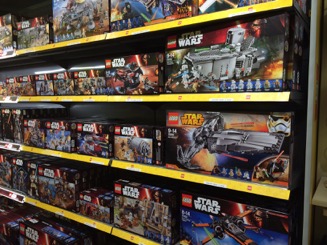Trans Scania tips for foreigners
23/08/16 21:51
Trans Scania is a small (~20 participants) 246km (153 mile) trail race across the South of Sweden (from the West coast to the East Coast and then most of the way back). It’s really well organised, but the only support during the race is a single drop-bag accessed at ~43 and ~116 miles. You can have a support crew if you want, but in 2016 most of the runners appeared not to. I’ve blogged about my experience of doing the race (and getting lost lots...) elsewhere. Here are some, hopefully useful, tips for non-Swedes doing the race in future:
1) Navigation
The maps are 1:50k scale and parts of the route wind through dense forests with multiple paths. The route is marked, but the markers aren’t directional and often aren’t in the most useful places (and on a couple of occasions appeared to do confusing things).
Unless you’ve got yoda-like navigation skills, having the route on a gps device will make your life a lot easier (and your run a lot faster). I’m usually an OK navigator. On a race like this I’d usually make a handful of mistakes, the vast majority of which would only cost me a couple of minutes. I don’t have enough digits to count the number of nav errors I made at Trans Scania. And lots of them were time-consuming (and distance adding). I’m guessing I possibly wasted 2 or 3 hours.
2) Food supplies
Check out the race Facebook page for locations and opening hours of supermarkets, cafes and water taps. They’re frequent enough that you don’t need to carry huge amounts of supplies, but rare enough that you need to plan. The most common supermarket (both in Sweden and on the race route) is ICA. It’s worth having a look around one in advance to see what they stock (there’s an ICA just outside the train station in Lund). There’s less ‘portable vegetarian running junk food’ than in the UK, IMHO. No cheese and onion pasties (one of my favourite multi-day running foods), but I wish British supermarkets sold drinking yogurt (lot of easy to consume calories).
3) Equipment: footwear & head torch
I’d suggest moderately (but not super) grippy, cushioned trail shoes. There’s a significant amount of road/hard track, but also some short, sharp ascents/descents on small stones/grit, and a lot of rutted/rooty paths. There are some field crossings. I can’t imagine they’d ever get as muddy as British field paths do. But if it rains lots in the run up, it’d be worth getting some local advice about underfoot conditions. I used Inov8 Race Ultra 290s and was happy with them (for reference I usually run UK canal tow path races in road shoes).
A head torch with variable brightness is useful, so you can up it a bit on technical sections and a lot when looking for trail markers. I used a Petzl Myo RXP, and again was happy with it (I don’t think something with a brighter max would have made looking for route markers in the dark any easier).
4) Wildlife
There’s lots. I saw (and hurdled...) my first ‘wild’ snake (it was a very small one though). The cattle don’t seem particularly aggressive. I wouldn’t suggest trying to run through them. But, in my experience, even the herds with a bull in, can easily be walked around or, if necessary, shooed off the path. On the other-hand wild boar (who aren’t used to humans coming through their home at night) should be given a wide berth...
5) Electric fences
There are lots of them, they’re live and give you a hefty kick if you touch them for too long. However if you think you need to climb one, something has gone wrong. Some of them have rubber handles and hooks which allow you to lift the top wire and step over the bottom one. Others have hidden squeeze routes around the sides.
6) Pacing
I probably shouldn’t make sweeping generalisations about nationalities on the basis of my personal experience of two Swedish ultras. But I will. Swedes are, on the whole, much, much better at pacing than Brits. In a 100+ mile race in Britain I’d expect to be off the back of the pack for the first ~20 miles, and then slowly work my way up to mid-field (on a good day at least...). At Trans Scania, despite running even more slowly than usual, there were a handful of people not far ahead of me for the first few hours. And even if I’d been fit, I wouldn’t have been able to run/walk at as close to even pace as most of the rest of the field.
7) Logistics
The easiest place to fly into is Copenhagen. There are regular trains to Lund, taking ~45 minutes (a bit more in the incoming direction due to passport checks, a bit less in the opposite direction). Hotel Lundia, is right next to the finish, close to the train station, reasonably priced and very Scandinavian. In Copenhagen, CabinInn Metro is very basic, but cheap and conveniently located (close to the train line for Lund and 2 stops from the airport).
Check-in and security at Copenhagen airport are (as with most Nordic things) remarkably efficient, and there are some decent shops in departures. Including a Lego shop with an excellent selection of Star Wars lego...
